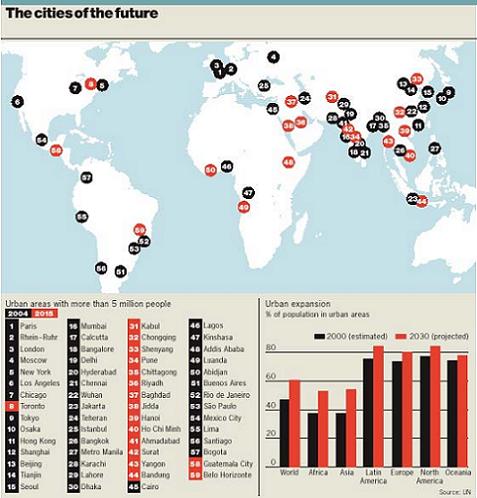The data of the report shows that five billion people, which is more than half of the world's population, are expected to live in cities in 2030. Tokyo will probably continue to lead the table as the most populated city. After her: Mexico City, New York-Newark, Bombay and Sao Paulo

Within two years half of the world's population will live in cities. so According to UN demographic data published tonight (Thursday'). According to the UN, this is a significant increase since 1950, when 30% of the world's population lived in urban areas.
According to the data of the United Nations Committee on Population and Development, 3.2 billion people, out of the approximately 6.5 billion living in the world today, live in cities and the number is expected to climb to approximately five billion people - which is approximately 61 percent of the world's population - by 2030.
The data also shows that there are more and more very large urban areas. 20 cities today have over ten million inhabitants, compared to only three such cities in 1975: Tokyo, New York-Newark, and Mexico City. In 1950, New York and Tokyo alone had over ten million inhabitants.
The five largest cities in the world, in terms of population size, are: Tokyo (35.3 million), Mexico City (19.2 million), New York-Newark (18.5 million), Bombay (18.3 million) and Sao Paulo (18.3 million). The next 15 cities on the list are: New Delhi, Calcutta, Buenos Aires, Jakarta, Shanghai, Dhaka, Los Angeles, Karachi, Rio de Janeiro, Osaka, Cairo, Lagos, Beijing, Manila and Moscow.
According to forecasts, the five most populated cities in the world in 2015 will be Tokyo (36.2 million), Bombay (22.6 million), New Delhi (20.9 million), Mexico City (20.6 million) and Sao Paulo (20 million).
Despite the increase in the number of urban areas, about half of the city's residents actually live in cities whose population does not exceed 500 thousand people. According to the data of the UN report, the percentages of urban settlement depend to a large extent on the level of development of the area. About three quarters of residents of developed areas live in cities, and only 43% of residents of less developed areas live in cities.
Even between continents, it turns out, there are differences between the percentages of urban settlement. 75% of the inhabitants of Latin America and the Caribbean live in cities compared to only 40% in Africa and Asia.
Moving to the cities
Alex Doron, 17/3/05
The world's population is becoming more and more urban - and less and less rural. New research done at the Earth Institute of Columbia University in the USA reveals that already 3 percent of our world's land surface is urban, twice as much as previously estimated. There are quite a few economic aspects to this matter. It is supposed to bring about a revolution in the definition of concepts such as city, town, rural area, populations.
The researchers managing the "Grump" project - acronym: the Global Rural/Urban Mapping Project, in which the World Bank also participates in financing and is done to a significant extent using NASA satellites - have now reported the following main findings: 20 percent of the world's urban settlements are populated by a maximum of half a million residents and this is of great importance, because so far an urban settlement has been defined according to UN experts as one where over half a million residents live.
Of the entire land area of the planet, 3 percent is already occupied by urban settlements - and this is an increase of 50 percent from previous estimates. Coastal areas are the most densely populated in the world and are home to 65 percent of the world's population, more than any other area. But when comparing continents, in Asia and Africa few urban residents live near beaches compared to America, Europe and Oceania and yet the density of coastal cities in Asia and Africa is greater than in all other continents.
About 7 percent of the world's urban population already lives in megacities - while previous estimates spoke of 4 percent of them. Megacities are those where more than 10 million inhabitants already live in each city.
All over the world there are 75 permanent settlements (that is, where at least a thousand people live) and are therefore clearly defined by the term "settlement" - but only 24 of them are defined as urban areas, with at least 5000 inhabitants or more, most of them the result of consolidation and merger between clusters of smaller settlements.
The head of the research team Dr. Deborah Balk said that the findings prove that there is no uniformity in the concept of city and urban area, that the size of a city determines. Coastal areas are more urban than others and even rural populations living near beaches, or in coastal ecosystems, are denser than in other rural areas.
An urban area is, according to the scientists' definition, an inhabited area that covers at least 1 square kilometer. Tokyo, which actually includes 500 towns connected together, has the largest urban area in the world and it covers 30 square kilometers.
